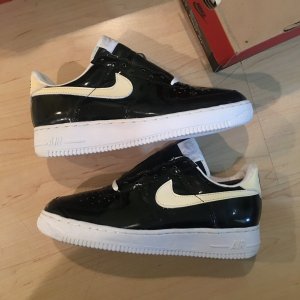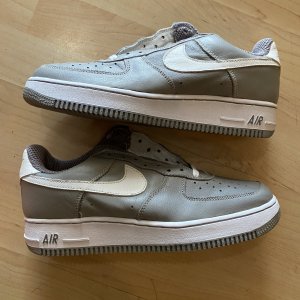Originally Posted by
vood99
Originally Posted by 8tothe24
As we discussed before, it costs Nike $5 to make a pair of shoes they sell for $100+. It comes down to that they are going to squeeze every penny out of their company to appease share holders. A company can only sell so many shoes. They make up extra profit by making internal cuts: personnel, resources, production techniques.
Nike could use the same leather but they choose to make money first. The fourth quarter earnings of 2011 alone was $645 MILLION (up 15%). Nike is at $101/share with 459 MILLION shares outstanding. Nike is anywhere from hurting.
So either real cows have become an endangered species or Nike is just yet another corporation seeking the all mighty dollar.
But I do agree, they are thinking they can pull a switch on a new generation of AF1 fanatics that don't know what they missed.
It's profit margins as you stated and there's helluva lot more money to be made by using the cheapest costing materials on the 'volume' product. Even Nike/JB signature product like the 'Brons and Kobes are constructed with synthetics like Hyperfuse and Flywire.
Funnily, Hyperfuse and Flywire work on Kobes and Brons as they are designed with synthetics in mind, but in the case of AF1s and other retro product - synthetics just don't work as they were never intended to have pleather or hyperfuse materials when they were originally designed.
Yeah, good points on both ends.
Warning, classic BIP opus coming -
See, the funny thing about the quality cost argument for AF1s is that the AF1 is the worst Nike model to which to attempt to apply that argument. When the Auburn Bos come back out and the quality is atrocious, one might be able to pass the sniff test with the argument that says, hey, they are same price as they were 20 years ago, but everything got more expensive, so how do you expect the same quality now. I will debunk this argument later, BTW. But, with the AF1, Nike has consistent raised retail, incrementally over the years to attempt to pace inflation. So, this isn't your typical retro where the price point matches the original model's.
And, Mr. Voo (sorry I always call you that, but being associated with Natural Elements is nothing but the highest praise) makes a good point too. Nike has made some attempts to retrofit (no pun intended) older models with newer tech - many people dismiss that as hybird gimmickry - and it is to a degree - but it's also a experiment in synthetic vs. natural. Nike has always experimented with materials, sometimes for pure creativity and forward-thinking reasons, and sometimes for nefarious profit-maximization means.
We can't totally ignore the fact that they are a business when determine what we think reasonable to expect from them, but I also think we have a right to have standards. Remember, Nike's history (and it's ancient history by now) was as the anti-business. The venture jumped off by Phil Knight basically fronting in the Far East and coming home like, damn, I gotta put together this outfit I've been claiming to have. They resisted going public for as long as possible and tried really hard not to give shares out beyond the core group. I mean it's quaint nowadays, but the company's roots are like a movie script/fairy tale. The irony of being such a passionate consumer is that it would be easier to grin and bear it if you didn't know what you know - you follow your love and passion all the way to reach resentment and dissatisfaction. ...That happens all the time, BTW, it's like the Peter Principle for hobbyists.
Going back to the debunking of the you can't expect OG quality for the same price 20 years later argument. First, we don't think of Nike as a technology company, but they took hold of the market by being the vanguard of innovation in their space - and then attaching that to some of the best advertising and market campaigns ever executed. But, there's a strong tech element to what Nike does. And, in any tech company, the cost of final products reflects the cost of R&D - of which I'm sure the was a ton for the classic models. In "Swoosh" you can read about how many years and how much effort went into the idea of getting "Air" into shoes. And, here's the element of this nobody really talks about - when companies charge you for the R&D that went into a product, they aren't talking about just the successful R&D, they're talking about all the failed prototypes and ideas that wound up in the garbage can too. The cost of the final product also includes the marketing budget. I'll talk about the pharma industry because its one I know very well.
When the pharma industry talks about how it takes $800M - $1.2B to produce a drug, they don't tell you how the arrive at the number. First, nearly half of that is marketing, mass marketing and direct to doctor, etc. marketing (you know they hire ex-college-cheerleaders to go from Dr. to Dr. with their push-up bras marketing their products, right? But, I digress). Then, the other half of the cost is the development of the drug. A company will create thousands of compounds and run tons of tests to identify the best ones, optimize them, tweak them, etc. When they determine how much it cost to make their product, they are including the cost of all the failed pursuits - failed clinical trials, failed everything that happened in pursuit of the product. This is not a negligible number - and I'm sure it wasn't one at Nike.
The cost of failure and the cost of marketing do not exist for Nike Retro. They don't do any marketing - but they did the first time around. This has already more than eclipsed the adjust MSRP for inflation consideration. But, wait, there's more.
One of the most common misconceptions about today's global economy is that nothing is made by hand anymore. That's not true. There are more goods made by hand today than ever before. When companies set up overseas and use exploited workers, the cost of production is nearly zero. It's cheaper to use 12-year-old Indonesians than to purchase and maintain expensive machines. I'm serious - listen to the This American Life from a few weeks ago about FoxConn and Apple if you doubt me. So, while sourcing the material may be more difficult - even though advances in factory farming probably shouldn't even imply that would be the case - the cost of production is still nearly zero.
So, Nike Retro has ostensibly no advertising expenses, no R&D expenses, and the cost of production is virtually non-existent. So, why again, is the idea that we can't expect OG quality a reasonable argument? The only answer is corporate greed. And, that's no shock at all. Complaining that corporations are greedy is like complaining that Uncle Luke is raunchy. But, there are two conclusions here. One, don't defend Nike because when you do that you are falling in love with you captors - Stockholm Syndrome. Two, and more importantly, what we want CAN happen - there's no fundamental reason why it can not - so people who really care have to vote with their wallets. And, for the most part we do. Team AF1 does the vast majority of our business on the secondary market - where Nike doesn't see a penny of it. I spend literally thousands of dollars every year on sneakers - Nike/JB probably sees 25% of that at most. Overall, they're winning, but among US - they're leaving money on the table and LOSING.






















